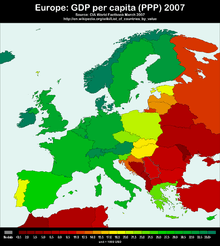Outline of the European Union

The location of the European Union
The following hierarchical outline is provided as an overview of and topical guide to the European Union:
The European Union (EU) is an economic and political union of 28 member states, located primarily in Europe.[1][2][3][4] Committed to regional integration, the EU was established by the Treaty of Maastricht on 1 November 1993 upon the foundations of the pre-existing European Economic Community.[5] With 500 million citizens, the EU combined generates an estimated 30% share (US$18.4 trillion in 2008) of the nominal gross world product.[6]
Origins
- History of the European Union
- European Communities
- Single market. See also Trade bloc and Value-added tax
- Subsidiarity
- See treaties below
Identity
Structures
_EN.svg.png)
Map showing the Member States of the European Union (clickable)
- Members
- Institutions
- European Commission
- European Parliament
- Council of the European Union (also named Council of Ministers or just Council)
- Court of Justice of the European Union
- European Court of Auditors
- European Central Bank (ECB)
- European Council
- Other bodies
- Related Organisations
- European Free Trade Association (EFTA)
- European Economic Area (EEA)
- Western European Union (WEU)
Law and policy

A map of the per capita GDP in Europe
- Treaties of the European Union – Founding and amending treaties (primary legislation)
- Treaty of Paris (1951)
- Treaty of Rome (1957)
- Merger Treaty (1965)
- Single European Act (1986)
- Treaty of Maastricht (1992)
- Treaty of Amsterdam (1997)
- Treaty of Nice (2001)
- Treaty of Accession 2003
- Treaty of Accession 2005
- Treaty of Lisbon (2007)
- Related documents
- EU Policy Areas
- European Union law
- Forms of Secondary Legislation
- Topics of Secondary Legislation
- Directives and Regulations of Secondary Legislation:
- European Company Statute
- Protected designation of origin
- Community patent
- Registration, Evaluation and Authorization of Chemicals
- Directive on the enforcement of intellectual property rights
- Directive 95/46/EC on the protection of personal data
- Directive on harmonising the term of copyright protection

A topographic map of Europe
Miscellaneous

A satellite composite image of Europe
- Economy of the European Union
- European Neighbourhood
- European Union statistics
- Euroscepticism, Europhobe
- European Union Association Agreement
- Pro-European, Europhiles
- Largest cities of the European Union by population within city limits
- Morocco–European Union relations
- Sport policies of the European Union
- United States of Europe
- Trade war
- Statewatch
- Supranational union
See also
Main article: European Union
- Outline of Europe
- G-20 major economies
- Outline of Austria
- Outline of Belgium
- Outline of Bulgaria
- Outline of Croatia
- Outline of Cyprus
- Outline of the Czech Republic
- Outline of Denmark
- Outline of Estonia
- Outline of Finland
- Outline of France
- Outline of Germany
- Outline of Greece
- Outline of Hungary
- Outline of Ireland
- Outline of Italy
- Outline of Latvia
- Outline of Lithuania
- Outline of Luxembourg
- Outline of Malta
- Outline of the Netherlands
- Outline of Poland
- Outline of Portugal
- Outline of Romania
- Outline of Slovakia
- Outline of Slovenia
- Outline of Spain
- Outline of Sweden
- Outline of the United Kingdom
References
- ↑ Jackson, James K. (9 March 2009). "The Financial Crisis: Impact on and Response by the European Union" (pdf). Federation of American Scientists: Congressional Research Service. p. 28. Retrieved 6 July 2009.
The European Union is a political and economic union of 27 member states, formally established in 1993 by the Treaty of Maastricht out of existing structures that had evolved in steps since the 1950s.
- ↑ Permanent Mission of France to the United Nations. "What is the European Union?". Archived from the original on 3 March 2009. Retrieved 6 July 2009.
Europe is a geographical and cultural notion. The European Union is a political and economic union among 27 States on the European continent
- ↑ "Cabinet statement on German EU Presidency". Regierung Online. Press and Information Office of the [German] Federal Government. 5 November 2006. Retrieved 6 July 2009.
The European Union is a political union...
- ↑ "European Union", New Oxford Dictionary of English, Oxford, UK: Oxford University Press, 2001, p. 635, ISBN 0-19-860441-6:"an economic and political association of certain European countries as a unit with internal free trade and common external tariffs...."
- ↑ Craig, Paul; Grainne De Burca; P. P. Craig (2006). EU Law: Text, Cases and Materials (4th ed.). Oxford: Oxford University Press. p. 15. ISBN 978-0-19-927389-8.; "Treaty of Maastricht on European Union". Activities of the European Union. Europa web portal. Retrieved 20 October 2007.
- ↑ "World Economic Outlook Database, April 2009 Edition". International Monetary Fund. April 2009. Retrieved 24 April 2009.
Gross domestic product, current prices; US dollars, Billions;
2007 = 16,927.173
2008=18,394.115
2009=15,342.908 [projection]
Gross domestic product based on purchasing-power-parity (PPP) valuation of country GDP; Current international dollar, Billions;
2007 = 14,762.109
2008 = 15,247.163
2009 = 14,774.525 [projection]
GDP based on PPP share of world total
2007 = 22.605%
2008 = 22.131% 2009 = 21.609% [projection]
World "GDP", current prices; US dollars, Billions;
2007 = 54,840.873
2008= 60,689.812
2009= 54,863.551 [projection]
These data were published in 2009. Data for 2009 are projections based on a number of assumptions.
This article is issued from Wikipedia - version of the 9/16/2016. The text is available under the Creative Commons Attribution/Share Alike but additional terms may apply for the media files.
